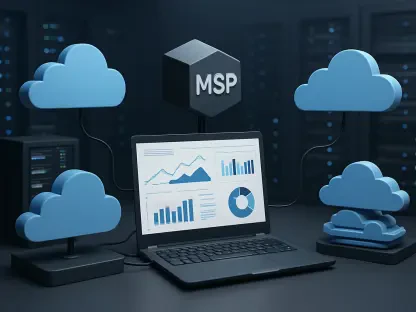As businesses increasingly migrate their data and applications to the cloud to leverage its convenience and cost-effectiveness, the associated cybersecurity risks have become more pronounced and complex. This dual nature—promising benefits while presenting substantial risks—necessitates a thorough understanding and proactive management approach to bolster cloud security. This article explores the need for strong cloud security measures and provides in-depth insights into addressing key vulnerabilities and risks associated with cloud environments.
Understanding Cloud Security Challenges
The Prevalence of Human Error and Misconfiguration
Human error and misconfiguration are among the leading causes of cloud security vulnerabilities, accounting for a significant percentage of breaches. The complexity of cloud infrastructure often leads to configuration errors, especially during the setup or scaling phases. These errors can create critical security gaps that become easy targets for cybercriminals. Furthermore, inadequate knowledge or oversight in managing cloud settings can result in unintended data exposures, highlighting the need for continuous training and robust oversight mechanisms.Even highly skilled IT professionals can sometimes overlook critical details in complex cloud architectures, leading to the exposure of sensitive data. Considering that cloud environments are often dynamic, with frequent updates and changes, the risk of misconfiguration remains consistently high. Organizations need to invest in automated configuration management tools that can detect and correct errors in real-time. Moreover, employing standardized configuration templates and adherence to best practices can reduce the likelihood of human error causing a security breach.
Exploitation of Known Vulnerabilities
Cyber attackers are constantly on the lookout for known vulnerabilities in cloud systems, which can be exacerbated by lapses in patch management. When systems are not regularly updated, they become vulnerable to exploits that could have been easily prevented through timely patches. This issue underscores the importance of automated patch management systems that ensure all components of the cloud infrastructure are up-to-date with the latest security updates. Moreover, businesses should adopt a proactive stance, conducting regular vulnerability assessments to identify and remediate potential weaknesses before they are exploited.Staying ahead of attackers requires a comprehensive patch management strategy that includes not just software updates but also firmware and hardware patches. Too often, organizations focus on application patches and overlook other critical components of their infrastructure. Integrating a unified patch management solution that covers all aspects of IT can significantly improve security posture. Additionally, organizations should participate in threat intelligence sharing communities to stay informed about the latest vulnerabilities and patch releases. Regularly scheduled downtime for patch implementation and system upgrades should also be planned, minimizing disruptions while ensuring security.
Enhancing Authentication and Access Controls
The Importance of Multi-Factor Authentication (MFA)
Multi-Factor Authentication (MFA) is a critical security measure that adds an additional layer of protection to cloud environments. MFA requires users to provide multiple forms of verification before gaining access, thus significantly reducing the risk of unauthorized access. Despite its proven effectiveness, many organizations still overlook the implementation of MFA, thereby leaving their systems vulnerable. Integrating MFA into the security framework can mitigate the risk of data breaches caused by compromised credentials.The reluctance to implement MFA often stems from concerns about user convenience and the potential for increased administrative overhead. However, the trade-off in enhanced security is invaluable. Modern MFA solutions offer user-friendly experiences such as biometric verification, making the authentication process smoother for end-users. Moreover, employing adaptive MFA can dynamically adjust the level of authentication required based on the user’s behavior and risk profile, providing a balance between security and usability. Organizations should also ensure that MFA is applied consistently across all access points, including remote and on-site systems, to maintain a uniform security standard.
Implementing Identity and Access Management (IAM)
Effective Identity and Access Management (IAM) controls are essential for regulating access to sensitive data within cloud environments. Implementing the principle of least privilege, where access is granted strictly based on the necessity of the specific role, is a recommended best practice. This approach minimizes the risk of insider threats and ensures that employees can only access the information necessary for their job functions. Additionally, robust IAM solutions should include regular access audits and the revocation of unused or unnecessary permissions to maintain security integrity.IAM systems should be integrated with existing directory services and cloud platforms to create a single source of truth for managing identities and access rights. This integration facilitates centralized management, reduces administrative burden, and helps in maintaining compliance with regulatory requirements like GDPR and HIPAA. Automation in IAM processes—for instance, auto-revoking access when an employee leaves the organization or changes roles—can prevent gaps in security. Additionally, deploying Just-In-Time (JIT) access provisioning that grants temporary privileges based on need can further tighten security without compromising operational efficiency.
Protecting Data Through Encryption and Secure APIs
The Role of Encryption in Data Protection
Encryption is a fundamental security practice that safeguards data both at rest and in transit by making it unreadable without the appropriate decryption keys. Storing data in plaintext format leaves it highly vulnerable to unauthorized access and breaches. Therefore, businesses must implement rigorous encryption standards to protect sensitive information. Deploying robust encryption protocols ensures that even if data is intercepted or accessed by unauthorized parties, it remains indecipherable and secure.Encryption strategies should encompass a comprehensive approach involving end-to-end encryption, ensuring that data is protected throughout its lifecycle across all applications and storage systems. Cloud Service Providers (CSPs) often offer built-in encryption options, but organizations should verify the strength and compliance of these encryption standards with their specific regulatory requirements. Additionally, key management practices must be meticulously managed, including key rotation and distribution. Utilizing hardware security modules (HSMs) for storing keys can add an extra layer of security by safeguarding cryptographic operations against unauthorized access or manipulation.
Securing APIs to Prevent Unauthorized Access
Application programming interfaces (APIs) facilitate data exchange between cloud services and applications but also represent potential attack vectors if not properly secured. Insecure APIs can expose cloud environments to various threats, including data leaks and unauthorized access. To counter these risks, businesses should employ centralized logging and continuous monitoring of API activity. Additionally, incorporating security measures such as web application firewalls and Distributed Denial of Service (DDoS) protection can further safeguard APIs from malicious attacks.API security should involve a multifaceted approach including token-based authentication, rate limiting to prevent abuse, and stringent input validation to mitigate injection attacks. Implementing OAuth for secure API authorization can control access levels effectively. Organizations should also consider API gateway solutions that provide a centralized point of control for routing, monitoring, and securing API requests. Regular audits and security testing of APIs are essential to identify potential vulnerabilities and rectify them promptly. By establishing a robust API security framework, organizations can ensure that their applications and data exchanges remain secure from emerging threats.
Fostering a Proactive Cybersecurity Culture
Regular Vulnerability Assessments
To proactively manage cloud security, organizations should conduct regular vulnerability assessments to identify and remediate any security gaps. These assessments enable businesses to stay ahead of potential threats by uncovering weaknesses before they can be exploited. Moreover, vulnerability assessments should be complemented with penetration testing to simulate real-world attack scenarios and evaluate the effectiveness of existing security measures.Utilizing automated vulnerability scanning tools can expedite the assessment process by quickly identifying common vulnerabilities across the cloud infrastructure. These tools should be used in conjunction with manual assessments for a thorough evaluation. Penetration testing should be performed by certified ethical hackers who can find hidden vulnerabilities that automated tools might miss. Reports from these tests should be actionable, providing clear recommendations for remediation. By continually assessing and reinforcing their security posture, organizations can build resilience against evolving cyber threats.
Implementing Comprehensive Security Awareness Programs
A strong cybersecurity culture is vital for mitigating human-related risks within cloud environments. This can be achieved through comprehensive security awareness programs that educate employees about best practices, potential threats, and the importance of adhering to security policies. Training sessions should be designed to cater to different roles within the organization, ensuring that all employees understand the specific risks associated with their responsibilities and how to mitigate them effectively.Interactive training modules, regular phishing simulations, and a culture of continuous learning can enhance the effectiveness of security awareness programs. Employees should feel empowered to report suspicious activities without fear of retribution, creating a proactive security environment. Senior management should lead by example, emphasizing the importance of security practices and reinforcing a top-down approach to cybersecurity. Additionally, periodic reviews and updates to training material are necessary to keep pace with the fast-evolving threat landscape, ensuring that the workforce remains vigilant and informed.
Ensuring Robust Patch Management and Data Deletion Practices
Timely and Effective Patch Management
Effective patch management is crucial for defending against zero-day vulnerabilities and other cyber threats. Delayed or inadequate patching can leave cloud systems exposed to significant risks, making it essential for organizations to adopt automated patch management solutions. These solutions ensure that updates are applied promptly across all components of the cloud infrastructure, thereby reducing the window of vulnerability and enhancing overall security posture.Patch management should be a continuous and automated process, with tools in place to validate the success of patch applications and roll back if any issues arise. Comprehensive patch management strategies should also include third-party software and not just core systems. Leveraging machine learning and artificial intelligence to predict and prioritize critical patches based on the specific risk profile of the organization can optimize this process. Regular audits to verify the correct application and effectiveness of patches can further fortify the security infrastructure, minimizing the opportunities for cyber threats to exploit known vulnerabilities.
Secure and Complete Data Deletion
As businesses increasingly shift their data and applications to the cloud, attracted by its convenience and cost advantages, the accompanying cybersecurity risks have grown more significant and intricate. This dual reality—offering substantial benefits while also posing considerable risks—requires a comprehensive understanding and a proactive management strategy to enhance cloud security. Strong cloud security measures are essential to protect sensitive data and ensure operational continuity. This article delves into the importance of robust cloud security protocols and provides detailed insights into addressing the primary vulnerabilities and threats associated with cloud computing environments. By identifying and mitigating these risks, organizations can better safeguard their assets, maintain regulatory compliance, and achieve a more secure cloud infrastructure. Whether you’re a small business or a large enterprise, recognizing the critical aspects of cloud security and implementing effective measures can make a significant difference in protecting your digital landscape.









